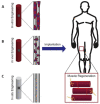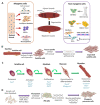Current Strategies for the Regeneration of Skeletal Muscle Tissue
- PMID: 34072959
- PMCID: PMC8198586
- DOI: 10.3390/ijms22115929
Current Strategies for the Regeneration of Skeletal Muscle Tissue
Abstract
Traumatic injuries, tumor resections, and degenerative diseases can damage skeletal muscle and lead to functional impairment and severe disability. Skeletal muscle regeneration is a complex process that depends on various cell types, signaling molecules, architectural cues, and physicochemical properties to be successful. To promote muscle repair and regeneration, various strategies for skeletal muscle tissue engineering have been developed in the last decades. However, there is still a high demand for the development of new methods and materials that promote skeletal muscle repair and functional regeneration to bring approaches closer to therapies in the clinic that structurally and functionally repair muscle. The combination of stem cells, biomaterials, and biomolecules is used to induce skeletal muscle regeneration. In this review, we provide an overview of different cell types used to treat skeletal muscle injury, highlight current strategies in biomaterial-based approaches, the importance of topography for the successful creation of functional striated muscle fibers, and discuss novel methods for muscle regeneration and challenges for their future clinical implementation.
Keywords: hydrogels; scaffold topographies; skeletal muscle cells; tissue engineering.
Conflict of interest statement
The authors declare no conflict of interest.
Figures






Similar articles
-
Biomimetic scaffolds for regeneration of volumetric muscle loss in skeletal muscle injuries.Acta Biomater. 2015 Oct;25:2-15. doi: 10.1016/j.actbio.2015.07.038. Epub 2015 Jul 26. Acta Biomater. 2015. PMID: 26219862 Free PMC article. Review.
-
Immunomodulation and Biomaterials: Key Players to Repair Volumetric Muscle Loss.Cells. 2021 Aug 7;10(8):2016. doi: 10.3390/cells10082016. Cells. 2021. PMID: 34440785 Free PMC article. Review.
-
Current Methods for Skeletal Muscle Tissue Repair and Regeneration.Biomed Res Int. 2018 Apr 16;2018:1984879. doi: 10.1155/2018/1984879. eCollection 2018. Biomed Res Int. 2018. PMID: 29850487 Free PMC article. Review.
-
Cell therapy to improve regeneration of skeletal muscle injuries.J Cachexia Sarcopenia Muscle. 2019 Jun;10(3):501-516. doi: 10.1002/jcsm.12416. Epub 2019 Mar 6. J Cachexia Sarcopenia Muscle. 2019. PMID: 30843380 Free PMC article. Review.
-
Evaluation of adipose-derived stem cells for tissue-engineered muscle repair construct-mediated repair of a murine model of volumetric muscle loss injury.Int J Nanomedicine. 2016 Apr 8;11:1461-73. doi: 10.2147/IJN.S101955. eCollection 2016. Int J Nanomedicine. 2016. PMID: 27114706 Free PMC article.
Cited by
-
Balenine, Imidazole Dipeptide Promotes Skeletal Muscle Regeneration by Regulating Phagocytosis Properties of Immune Cells.Mar Drugs. 2022 May 5;20(5):313. doi: 10.3390/md20050313. Mar Drugs. 2022. PMID: 35621964 Free PMC article.
-
Tuning Myogenesis by Controlling Gelatin Hydrogel Properties through Hydrogen Peroxide-Mediated Cross-Linking and Degradation.Gels. 2022 Jun 17;8(6):387. doi: 10.3390/gels8060387. Gels. 2022. PMID: 35735731 Free PMC article.
-
A Facile Strategy for Preparing Flexible and Porous Hydrogel-Based Scaffolds from Silk Sericin/Wool Keratin by In Situ Bubble-Forming for Muscle Tissue Engineering Applications.Macromol Biosci. 2025 Feb;25(2):e2400362. doi: 10.1002/mabi.202400362. Epub 2024 Oct 20. Macromol Biosci. 2025. PMID: 39427341 Free PMC article.
-
A Critical Review on Classified Excipient Sodium-Alginate-Based Hydrogels: Modification, Characterization, and Application in Soft Tissue Engineering.Gels. 2023 May 22;9(5):430. doi: 10.3390/gels9050430. Gels. 2023. PMID: 37233021 Free PMC article. Review.
-
Conductive Polymeric-Based Electroactive Scaffolds for Tissue Engineering Applications: Current Progress and Challenges from Biomaterials and Manufacturing Perspectives.Int J Mol Sci. 2021 Oct 26;22(21):11543. doi: 10.3390/ijms222111543. Int J Mol Sci. 2021. PMID: 34768972 Free PMC article. Review.
References
Publication types
MeSH terms
Substances
LinkOut - more resources
Full Text Sources
Medical

